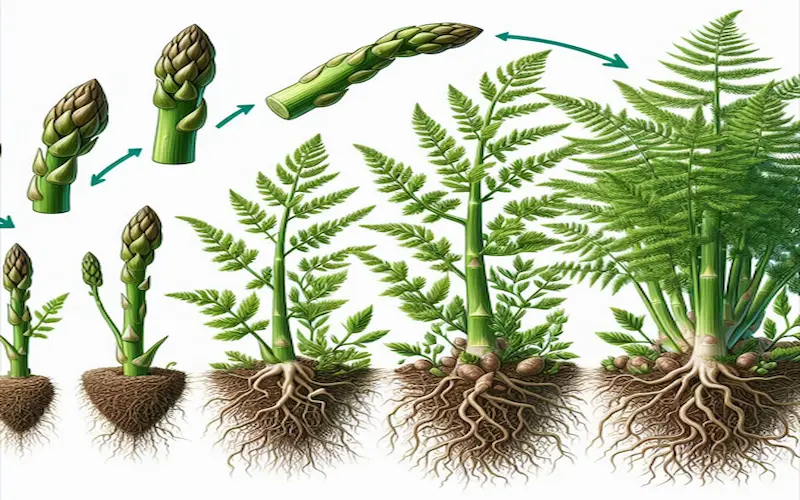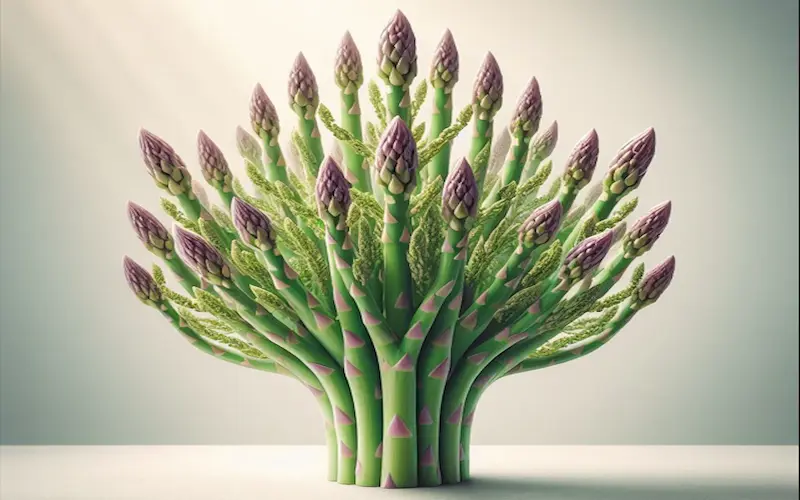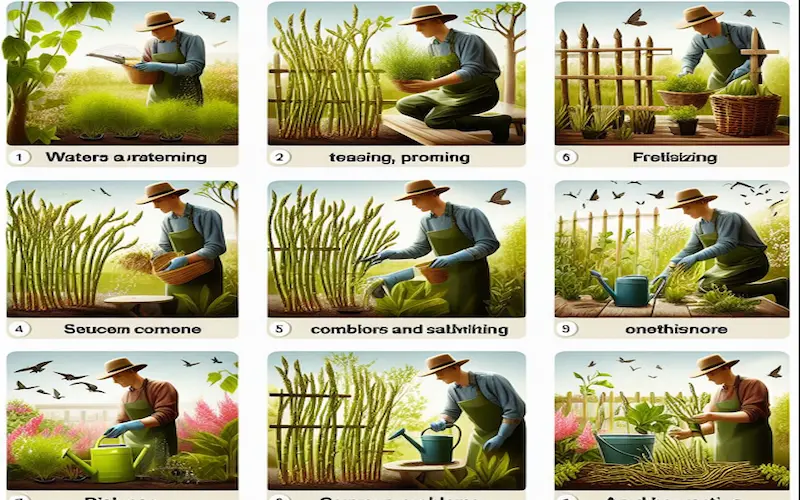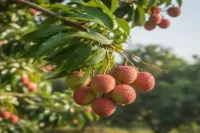Stages of Growing Asparagus: A Comprehensive Guide
Published: 2 Mar 2025
Asparagus is a perennial vegetable that grows for many years when properly maintained. It has unique growth characteristics and requires specific conditions for a healthy and productive harvest. Asparagus is a popular and nutritious vegetable that can be valuable to any home garden. In this comprehensive guide, I will explain the stages of growing asparagus, from selecting the suitable variety to harvesting and storing your crop.
| Scientific Name | Asparagus officinalis |
| Plant Type | Perennial |
| Native Environment: | Western Asia & Mediterranean |
| Growth Rate | Slow growth rate |
| Plant Size: | Able to reach 8′ tall |
| Growing Zones: | USDA Zoon 3-8 (receive cold winter temperature) |

Selecting the Right Variety
Choosing a suitable variety of asparagus is crucial for successful growth. There are several factors to consider, such as climate, soil conditions, and personal preferences. Some popular varieties include:
- Jersey Knight: This variety is known for its high productivity and disease resistance, making it a favorite among home gardeners. It produces thick, tender spears with excellent flavor.
- Purple Passion: As the name suggests, this variety is known for its vibrant purple color. It has a slightly sweeter flavor than green asparagus and adds color to your dishes.
- Mary Washington: A traditional and widely grown variety, Mary Washington is known for its hardiness and reliability. It produces medium-sized, flavorful spears.
When selecting a variety, consider your local climate and the length of your growing season. Some varieties are better suited for cooler temperatures, while others thrive in warmer regions. Additionally, consider the soil conditions in your garden, as certain varieties may prefer sandy or loamy soil.

Growth Characteristics of Asparagus
- Asparagus grows in stages, with the first years focusing on root development rather than spear production.
- It grows thin, feathery ferns that store energy for the next growing season.
- Mature asparagus plants can produce spears for 15-20 years if properly maintained.
- The spears proliferate in spring, sometimes up to 10 inches daily in warm conditions.
Growing Conditions for Healthy Asparagus
To ensure healthy asparagus plants, you need to provide the right growing conditions:
Soil:
Asparagus prefers well-drained, sandy loam soil with a pH between 6.5 and 7.5.
Sunlight:
Asparagus requires 6-8 hours of direct sunlight daily for better growth.
Watering:
Asparagus needs 1-2 inches of water per week during active growth.
Temperature:
Asparagus grows best in temperatures between 70-85°F (21 and 29°C). These conditions support healthy spear growth and encourage the plant to establish a strong root system.
Spacing:
For optimal growth and productivity, Plant the asparagus crowns 12-18 inches apart within a row, giving each plant enough space to develop a strong root system.
Space the rows 3-4 feet apart to allow the fern-like foliage to spread after the spears are harvested. This spacing also makes weeding, watering, and fertilizing more manageable, preventing competition for nutrients and sunlight. Adequately spaced plants will establish deep roots, producing a productive asparagus bed yielding high-quality spears for 15-20 years.

Different Growing stages of Asparagus
Understanding the growing stages of asparagus is essential for successful cultivation of this delicious and nutritious perennial vegetable. Asparagus has three main stages: establishment, spear production, and fern growth. During the establishment stage, which lasts around two years, newly planted crowns develop a robust root system and establish themselves in the soil.
Once established, the spears begin to emerge in the spring, signaling the start of spear production. This stage can last for several weeks, during which the spears are harvested when they reach 6 to 8 inches in height.
As the spear production wanes, the fern growth stage begins, allowing the plant to replenish its energy reserves through photosynthesis. During this stage, the spears can grow into tall, feathery ferns, which capture sunlight and produce nutrients for the crown to store for the next growing season. Understanding and managing these growing stages is crucial for maintaining a healthy and productive asparagus patch year after year.

Planting: Stages of Growing Asparagus
Asparagus can be planted using either seeds or crowns. While growing from seeds allows for a more comprehensive selection of varieties, it requires more time and patience. Planting asparagus crowns, on the other hand, provides a head start and results in an earlier harvest. Here’s how to grow asparagus using crowns:
- Dig trenches: Dig trenches 8-12 inches deep and 18-24 inches apart. The trenches should be long enough to accommodate the number of crowns you have.
- Space the crowns: Place the crowns in the trenches, spreading the roots out evenly. Space them about 18-24 inches apart for proper growth and airflow.
- Cover with soil: Cover the crowns with about 2 inches of soil, ensuring the buds face upward. As the asparagus grows, gradually fill in the trenches with more soil until they are level with the ground. Water thoroughly: After planting, water the crowns thoroughly to ensure good root establishment.

Germination and Shoot Emergence
Germination is the first stage in the life cycle of asparagus. It usually occurs 2-3 weeks after planting the seeds or crowns. During this stage, the seeds or crowns develop roots and shoots that eventually emerge from the soil.

If you’re starting from seeds, soak them in water overnight before planting to improve germination rates. Plant the seeds about 1/2 inch deep in well-prepared soil, keeping them moist until germinating.
Once the shoots emerge, proper care is essential. Asparagus shoots are delicate and need protection from harsh weather conditions and pests. Cover the emerging shoots with soil or straw, exposing only the tips. This helps prevent the shoots from drying out and protects them from frost.

Asparagus Crowns
After the shoots emerge, they continue to grow and form a crown. The crown is the central part of the asparagus plant from which the shoots and roots emerge. It serves as a storage organ, allowing the plant to store energy for future growth and production.
As the crown develops, it will become larger and more robust. The roots will spread out, anchoring the plant in the soil and absorbing nutrients and water. The shoots will grow taller, reaching their full height of 3-5 feet.
We provide adequate water and nutrients to support the crown formation during this stage. Mulching around the plants can help retain moisture and suppress weeds. Regular fertilization with a balanced fertilizer, such as a 10-10-10 NPK ratio, is also recommended to ensure healthy crown development.

Foliage Development
Foliage development is a crucial stage in the growth of asparagus plants. During this stage, the shoots grow and mature into fern-like foliage. The foliage serves multiple purposes, including photosynthesis and energy storage for future growth.
The feathery green shoots of asparagus can be attractive and add texture to your garden. However, it’s important to note that asparagus ferns are not true ferns but rather modified leaves. These ferns play a vital role in the overall health and vigor of the asparagus plant.
Ensure your asparagus plants receive adequate sunlight and water to promote healthy foliage development. Asparagus prefers full sun to partly shaded areas; pick a spot that receives at least 6 to 8 hours of direct sunshine daily.
Water the plants deeply, especially during dry spells, to prevent the ferns from wilting.

Flowering
Depending on the species and climate, asparagus plants usually blossom in late spring or early summer.
The flowers are small and inconspicuous, usually yellow-green. While the flowers are not edible, they play a crucial role in seed production.
Asparagus plants are either male or female, with male plants producing more abundant and showier flowers. Female plants, on the other hand, have edible spears. Insects, especially bees, pollinate the flowers by moving pollen from male to female.

Having both male and female plants is essential to saving seeds. However, focusing on male cultivars is recommended if you’re growing asparagus primarily for its edible spears. Male plants do not expend energy on seed production, resulting in more vigorous spear growth.
Berry Formation
After flowering, female asparagus plants will produce small red berries. These berries contain seeds and are attractive to birds, which can help disperse the seeds throughout your garden. If you prefer to avoid having asparagus plants popping up in unexpected places, removing the berries or preventing the plants from producing them is best.
While asparagus berries are not edible and can be toxic to humans and pets, they can be collected for seed propagation. If you wish to order the berries, let them ripen fully on the plant before harvesting. Store the seeds in a cool, dry place and plant them in a different location the following season if desired.

Dormancy
As the growing season ends, asparagus plants enter a period of dormancy. Dormancy usually occurs in the fall when the weather becomes calm and the foliage starts to die back. During this time, providing the necessary care to prepare the plants for winter is essential.
Before winter arrives, cut back the ferns a few inches above the ground. This helps to remove any diseased or yellow leaves and allows the plants to conserve energy. Apply a layer of mulch, such as shredded leaves or straw, over the soil to protect the roots from frost and maintain moisture.
During dormancy, it’s important to avoid disturbing the delicate asparagus roots. Be careful when working around the plants, and refrain from planting or digging in the asparagus patch until the following spring.

Harvesting Asparagus
- First Harvest (Year 3-4): Harvest only lightly in the third year to allow plants to grow strong.
- Harvest Season: Typically lasts 6-8 weeks in spring.
- Best Time to Harvest: Cut spears when they reach 6-9 inches tall and are still firm.
- Harvest Method: Use a sharp knife or snap spears off at ground level.
Storage of Fresh Asparagus
To keep asparagus fresh for longer:
Refrigeration: Wrap the ends in a damp paper towel and store in a plastic bag for up to 7 days.
Water Storage: Place spears in a jar with 1 inch of water and cover loosely with a plastic bag.
Freezing: Blanch spears for 2-3 minutes, then freeze for long-term storage.
Canning or Pickling: Store asparagus in jars with brine for extended use.
Final Thoughts: Growing asparagus takes patience but can be produced for decades with the right care. Proper soil preparation, weed and pest control, timely harvesting, and storage will ensure a successful asparagus garden.

Tips and Tricks for Successful Growth
Growing asparagus can be a rewarding but somewhat challenging endeavour. Here are some tips and tricks to help you achieve successful growth and a bountiful harvest:
- · Select the suitable variety: Choose a variety of asparagus well-suited to your climate and soil conditions. Consider factors such as cold hardiness, disease resistance, and flavour preferences.
- · Prepare the soil: Rich in organic matter, well-draining soil is ideal for asparagus growth. Treat the soil before planting with compost or well-rotted manure to increase fertility and drainage.
- · Plant correctly: Asparagus should be planted in early spring when the soil has warmed up. Avoid planting in wet or waterlogged soil, which can lead to root rot.
- · Proper spacing: Give each asparagus plant enough space to grow and spread its roots. Space the plants 18-24 inches apart for proper growth and airflow.
- · Mulch and weed control: Cover the plants with organic mulch, like crushed leaves or straw, to keep moisture and weeds at bay.
. Regularly remove weeds that may compete with the asparagus for nutrients and water.
- · Regular watering: Asparagus plants require consistent moisture, especially during dry spells. Water deeply and regularly, aiming for about 1 inch per week. Avoid overwatering, as this can lead to root rot.
- · Fertilization: Asparagus plants benefit from regular fertilization to maintain their health and productivity. Use a balanced fertilizer with a ratio of 10-10-10 or similar, applying it according to the package instructions.
- · Pest and disease management: Monitor your asparagus plants for common pests such as aphids, beet armyworms, and asparagus beetles. Use organic pest control methods, such as neem oil, to manage infestations. Watch out for diseases like Fusarium wilt and crown rot, and take preventive measures such as proper sanitation and soil management.
- · Proper harvesting: Wait until the asparagus plants are mature enough before harvesting. Snap or cut the spears at ground level when they reach a length of 6-8 inches. Avoid overharvesting to allow the plants to develop and store energy for future growth.
By following these tips and tricks, you can create an optimal growing environment for your asparagus plants and enjoy a successful harvest year after year.
Weed Control for Asparagus
Weeds compete with asparagus for nutrients, sunlight, and water. Here’s how to control them:
Mulching: To suppress weeds, apply a 2-3 inch layer of mulch (straw, compost, or grass clippings).
Hand Weeding: Remove weeds by hand to avoid disturbing asparagus roots.
Cover Crops: Grow cover crops like clover in winter to prevent weed growth.
Pre-emergent Herbicides: Organic or chemical weed suppressants can be used before asparagus spears emerge.
Pest Control for Asparagus
Asparagus plants can be affected by pests that damage spears and ferns. Common pests include:
Asparagus Beetles: Chew on spears and leaves. Control them with handpicking or neem oil spray.
Cutworms: Attack young spears. Use row covers or natural predators like birds.
Aphids: Cause stunted growth. Spray with soapy water or neem oil.
Fungal Diseases: Avoid overwatering and ensure good air circulation to prevent fungal infections
Common Problems and Solutions
Growing asparagus is challenging, as the plants can be susceptible to various pests, diseases, and environmental factors. Here are some common problems you may encounter and their possible solutions:
- · Asparagus aphids: These tiny insects can infest the foliage and cause stunted growth. To control aphids, use organic neem oil or introduce natural predators such as ladybugs or parasitic wasps.
- · Beet armyworms: These caterpillars can damage asparagus plants by feeding on their foliage. Control them using a neem oil solution or disrupt their lifecycle by drenching the soil with neem oil.
- · Asparagus beetles: If left unchecked, these beetles can defoliate plants. Remove them by handpicking or using an insecticidal soap.
- · Fusarium wilt: This fungal disease can cause wilting and death in asparagus plants. Unfortunately, there is no cure for Fusarium wilt. To prevent the spread of the disease, remove and destroy affected plants and soil.
- · Crown rot: Crown rot is another fungal disease that affects the roots and stems of asparagus plants. Prevent crown rot by maintaining proper soil drainage and avoiding overwatering or saturated conditions.
- · Soil pH imbalances: Asparagus prefers slightly acidic to neutral soil with a pH of 6.5-7. Regularly test your soil’s pH and adjust it using lime or elemental sulfur if necessary.
Regular monitoring, proper sanitation, and cultural practices like crop rotation can help prevent and manage these common problems. By staying vigilant and taking prompt action, you can maintain the health and productivity of your asparagus plants.

Conclusion
Growing asparagus is a rewarding and worthwhile endeavour that can provide fresh and delicious spears for years. By understanding the different stages of growing asparagus and providing the necessary care, you can enjoy a bountiful harvest and savour the unique flavour of homegrown asparagus.
Note: The information provided in this article is based on general practices and may vary depending on specific growing conditions and regional factors. Always consult local gardening resources and experts for tailored advice and recommendations.
Faqs about Stages of Growing Asparagus
Asparagus is a slow-growing vegetable that requires patience and proper care. The total time for Asparagus to reach full maturity depends on the growing method:
- From Seeds: It takes 3 to 4 years for the plant to mature fully and be ready for harvest.
- From Crowns (1-Year-Old Roots): If you start with asparagus crowns, you can harvest in the second year, though full production takes about 3 years.
- Annual Growth Cycle: Asparagus spears emerge in early spring, and the harvesting season lasts 6-8 weeks.
Though Asparagus takes time to establish, a well-maintained bed can be produced for 15 to 20 years, making it a worthwhile long-term investment
The life cycle of Asparagus consists of several stages:
- Seed Germination (Weeks 1-10): Asparagus takes 3-10 weeks to germinate when growing from seeds
- Seedling Stage (Months 2-6) – Tiny asparagus plants develop thin stems and roots.
- Establishment Phase (Year 1-2) – Plants grow fern-like foliage that strengthens the root system.
- First Harvest (Year 2-3): Small harvests can begin in the second year if grown from crowns.
- Full Production (Year 3-4 and beyond) – Mature asparagus plants produce thick, edible spears each spring for up to 20 years.
- Dormancy (Winter Months) – In fall, the fern-like leaves turn yellow and die, signaling winter dormancy.
This perennial vegetable follows a cycle of regrowth each year, making it a sustainable and rewarding crop.
The number of spears each asparagus plant produces depends on age, health, and variety. Here’s what to expect:
- Young Plants (Year 2-3): Each plant may produce 5-10 spears per season.
- Mature Plants (Year 3+): A healthy plant produces 20-25 spears per season.
- Peak Production (Years 5-10): With ideal care, a single asparagus crown can yield ½ to 1 pound of Asparagus per year.
Since Asparagus is a perennial crop, its yield improves with time. Planting 10-20 crowns is recommended for a continuous home supply.
When Asparagus first emerges from the ground, it looks like:
- Thin green or purple spears poking through the soil.
- Small, pointed tips that resemble mini spears.
- Smooth, scale-covered stalks that grow quickly in warm weather.
- Fern-like foliage develops if the spears are left unharvested.
New spears proliferate in early spring, often growing several inches daily in ideal conditions. If left to mature, these spears turn into tall, feathery green ferns that nourish the plant for next year’s harvest

- Be Respectful
- Stay Relevant
- Stay Positive
- True Feedback
- Encourage Discussion
- Avoid Spamming
- No Fake News
- Don't Copy-Paste
- No Personal Attacks



- Be Respectful
- Stay Relevant
- Stay Positive
- True Feedback
- Encourage Discussion
- Avoid Spamming
- No Fake News
- Don't Copy-Paste
- No Personal Attacks




